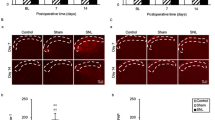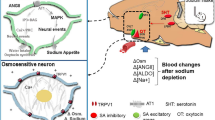Abstract
It has been suggested that arginine vasopressin (AVP) is involved in the retention of learned responses, in addition to its classical physiological functions of water retention and modulation of blood pressure. AVP administered subcutaneously (s.c.), intraventricularly or intracerebrally can prolong extinction of active avoidance behaviour1,2 and can enhance retention in inhibitory (passive) avoidance3–5. These effects have been interpreted as a direct action of AVP on the central nervous system to facilitate memory consolidation3,4. AVP also has facilitatory effects on cognitive function in humans6, and marked deficits in AVP function have been associated with certain types of psychopathology7. Alternative hypotheses for the behavioural actions of AVP have involved motivational constructs such as arousal8, and our recent work has focused on the role of arousal resulting from the activation of peripheral visceral signals in the behavioural effects of peripherally administered AVP9–12. The development of a specific antagonist for AVP13, 1-deaminopenicillamine-2-O-methyl tyrosine arginine vasopressin (dPTyr(Me)AVP), which can reverse the behavioural effects of exogenously administered AVP9–12, has provided a powerful tool for examining the role of AVP in the behavioural responses produced by physiological challenges known to release vasopressin. However, the relationship between the behavioural effects of exogenously administered AVP and the behavioural function of endogenously released AVP has not been evaluated. We report here that a potent peripheral osmotic stimulus, the intraperitoneal (i.p.) injection of hypertonic saline, at doses known to release AVP both centrally14 and peripherally15, will produce behavioural effects similar to those of exogenously administered AVP. Furthermore, the prolongation of active avoidance induced by this osmotic stimulus is reversed by pretreatment with dPTyr(Me)AVP, suggesting that endogenously released AVP may also produce behavioural effects.
This is a preview of subscription content, access via your institution
Access options
Subscribe to this journal
Receive 51 print issues and online access
$199.00 per year
only $3.90 per issue
Buy this article
- Purchase on Springer Link
- Instant access to full article PDF
Prices may be subject to local taxes which are calculated during checkout
Similar content being viewed by others
References
Walter, R., Van Ree, J. M. & De Wied, D. Proc natn. Acad. Sci. U.S.A. 75, 2493–2496 (1978).
Koob, G. F. et al. Regulat. Peptides 1, 153–164 (1981).
Bohus, B., Ader, R. & De Wied, D. Horm. Behav. 3, 191–197 (1972).
Bohus, B., Kovacs, G. L. & De Wied, D. Brain Res. 157, 414–417 (1978).
LeBrun, C. J. et al. Life Sci. 35, 1505–1512 (1984).
Weingartner, H. et al. Science 211, 601–603 (1981).
Gold, P. W., Kaye, W., Robertson, G. L. & Ebert, M. New Engl. J. Med. 308, 1117–1123 (1983).
Sahgal, A. Psychopharmology 83, 215–228 (1984).
Le Moal, M. et al. Nature 291, 491–493 (1981).
Koob, G. F. & Bloom, F. E. A. Rev. Physiol. 44, 571–581 (1982).
Ettenberg, A., Le Moal, M., Koob, G. F. & Bloom, F. E. Pharmac. Biochem. Behav. 18, 645–647 (1983).
Ettenberg, A., van der Kooy, D., Le Moal, M., Koob, G. F. & Bloom, F. E. Behav. Brain Res. 7, 231–250 (1983).
Bankowski, K., Manning, M., Haldar, J. & Sawyer, W. H. J. med. Chem. 21, 850–853 (1978).
Rodriquez, F., Demotes-Mainard, J., Chauveau, J., Poulain, D. & Vincent, J. D. Neurosci. Abstr. 9, 445 (1983).
Dunn, F. L., Brennan, T. J., Nelson, A. E. & Robertson, G. L. J. clin. Invest. 52, 3212–3219 (1973).
Koob, G. F., Thatcher-Britton, K., Britton, D. R., Roberts, D. C. S. & Bloom, F. E. Physiol. Behav. 33, 479–485 (1984).
Crofton, J. T. et al. Hypertension 1, 31–38 (1979).
Zaidi, S. M. A. & Heller, H. J. Endocr. 60, 195–196 (1974).
Reppert, S. M., Artman, H. G., Swaminathan, S. & Fisher, D. A. Science 213, 1256–1257 (1981).
Ermisch, A., Landgraf, K., Heinold, G. & Stuba, G. in Neural Plasticity and Memory Formation (eds Marsan, C. A. & Matthies, H.) 147–152 (Raven, New York, 1982).
Wood, J. H. Neurosurgery 11, 293–305 (1982).
Pardridge, W. M. A. Rev. Physiol. 45, 73–82 (1983).
Buijis, R. M. Cell Tissue Res. 192, 423–435 (1978).
Burbach, J. P. H., Kovacs, G. L., De Wied, D., Van Nispen, J. W. & Greven, H. M. Science 221, 1310–1312 (1983).
De Wied, D., Gaffori, O., Van Ree, J. M. & De Jong, W. Nature 305, 276–278 (1984).
Le Moal, M., Koob, G. F., Mormede, P., Dantzer, R. & Bloom, F. E. Soc. Neurosci. Abstr. 8 (1982).
Ettenberg, A. Behav. Brain Res. 14, 201–211 (1984).
Le Brun, C. J., Le Moal, M., Koob, G. F. & Bloom, F. E. Regulat. Peptides (in the press).
Iversen, S. D. Nature 291, 454 (1981).
Joyce, E. M. & Koob, G. F. Psychopharmacology 73, 311–313 (1981).
Author information
Authors and Affiliations
Rights and permissions
About this article
Cite this article
Koob, G., Dantzer, R., Rodriguez, F. et al. Osmotic stress mimics effects of vasopressin on learned behaviour. Nature 315, 750–752 (1985). https://doi.org/10.1038/315750a0
Received:
Accepted:
Published:
Issue Date:
DOI: https://doi.org/10.1038/315750a0
This article is cited by
-
An hypothesis on the role of glucose in the mechanism of action of cognitive enhancers
Psychopharmacology (1989)
-
Modulation of social memory in male rats by neurohypophyseal peptides
Psychopharmacology (1987)
Comments
By submitting a comment you agree to abide by our Terms and Community Guidelines. If you find something abusive or that does not comply with our terms or guidelines please flag it as inappropriate.



